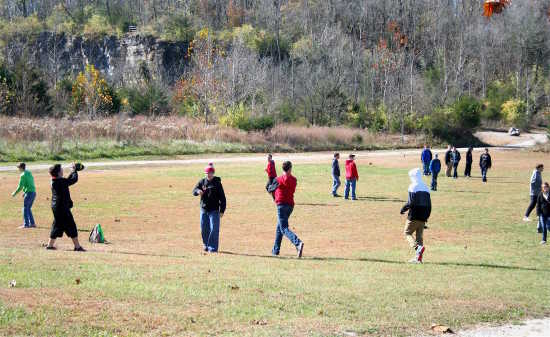Students have fun, learn at DePauw Nature Park

South Putnam Middle School students enjoyed a day of fine fall weather recently, trading their desks and chalkboards for the sites and sounds of the DePauw Nature Park.
The field trip, hoped to be the first of many, was highlighted by trails, learning stations and one dedicated ecologist named Vanessa Fox.
Park Ecologist Fox and Park Superintendent Jeremiah Sutherlin have the pleasure of looking after the reserve and are now interested in expanding the park to officially include residents of Greencastle.
Through four separate surveys conducted on the highly-rated website surveymonkey.com (links at story's end), Fox and Sutherlin feel they will soon have confirmation that the park and the local community could each benefit from officially being open to the public.
These ongoing surveys focus on residents, students, DePauw alumni and DePauw staff to determine further usage, development and management of the park. The data collected will be used to deliver accurate recommendations to the Nature Park Advisory Committee and the university's administration.
"We're looking ahead at how we can make the best use of the nature park, (for example) hosting student groups like this," Fox said. "My colleagues and I wrote a report with all the information in there and we had a meeting with the entire committee -- there are about 10 or 12 people who sit on the committee representing our various constituents on campus as well as the residents of Greencastle."
The park consists of 520 acres of wilderness that varies greatly and, as an ecologist, Fox is interested in the relationships between plants, animals and their surrounding environments. The original quarry, constructed in 1917 by then-owner and operator Hanson Aggregates (a.k.a Hanson Building Materials), carved into the area's limestone deposits. The limestone was then crushed, sorted and distributed by the quarry's mill and shipped to regions around the country until its closing in 1977 after the France Stone Company purchase. The Putnam County Recorder's Office has no record of official use post-1979.
After again being purchased by Hanson Building Materials in 1991, the company donated most of the land to DePauw University in 2003. DePauw has since purchased the adjacent land to form the current property.
The limestone was cut nearly 50-feet deep in some areas, forming man-made ponds and streams throughout the property; the area comprising of Quarry Pond, the park's largest and most centrally-located body of water, is only six feet deep at it's lowest point. This, Fox explained, is due to an underground cave system that covers most of southern Indiana.
"The water actually lies above a ground-water aquifer," Fox said. "As far as why it' so shallow -- when they excavated the limestone they didn't want the quarry to fill up (with water), so they took dynamite and excavated an underground cave (so) the pond would drain into Big Walnut Creek, which forms the western boundary of the Nature Park."
Due to the area's extensive history, the wildlife has become considerably diverse in recent years. Thermal-riding turkey vultures, feeder-friendly fish, a plethora of salamanders and that curious creature known as the homo-sapien already share the land, so the thought of opening the park to a more extensive demographic may appeal to the Advisory Committee when it makes its decision.
Along with the students, Fox said visitors can benefit from the area's 300-million years of progress by learning about crynoid, bryozoam and brachiopod fossils, as well as more recent features such as the layers of history hidden within the towering stone walls.
"We like to say that these walls began forming when Indiana was covered in a shallow sea," Fox explained. "There were all of these organisms that lived in the water that formed the limestone from the calcium-carbonate in the water."
As well as fossils and other geographical features unique to the park, several modern facilities have been constructed for the education of all who visit. The Ian and Mimi Rolland Welcome and Activities Center, the Manning Environmental Field Station, the Janet Prindle Institute for Ethics, the Bartlett Reflection Center, a Quarry Research Area, an ampitheatre and multiple campground locations dot the landscape.
For more information about the park and its possible development, those interested are encouraged to visit depauw.edu to learn about its history and upcoming events. To take online survey, visit the appropriate link:
* Community -- www.surveymonkey.com/r/2LBPDTF
* Students -- www.surveymonkey.com/r/2V7WMYY
* Alumni -- www.surveymonkey.com/r/2VJFK7M
* Faculty and staff -- www.surveymonkey.com/r/2VR5GC9
